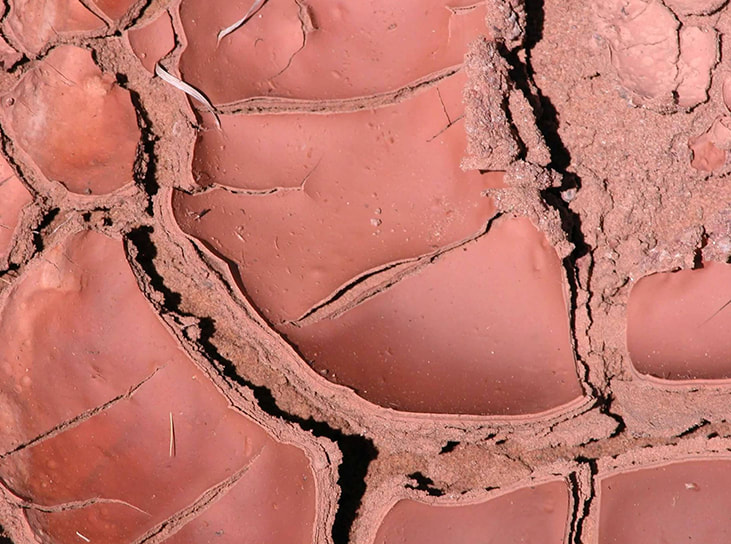|
An inquiring raven settles into a thermal overhead, circling, circling, circling closer to see what has settled into one of the metal folding chairs on Elk Ridge. From the western rim of the box canyon, an eastern sun continues to rise on this 25-degree winter day as it allows the raven to cast its shadow on the sandy precipice of the canyon’s northern rim. The raven glides effortlessly as its shadow dances, appearing and disappearing across the scratches of erosion on the barranca. These are the drainages, the paths of fallen rain, the funnels to the arroyo below. These are the evidence of the times before the rain evaporated prior to reaching the earth. Traces of snow remain on north slopes or on the north side of rocks and trees. It slowly gives up its moisture not to the thirsty ground but to the kiln dry air. The evidence is the crystalline surface of the snow. It is evaporating. The raven, apparently satisfied, departs to the west perhaps on his way to work at the butcher’s field of carcasses and bones in El Rito. Breakfast this morning, and then possibly lunch at Bode’s dumpster farther west and north in Abiquiu. There’s plenty to see and plenty of thermals to ride along the way. From the chair, the due east panorama, a line of north to south mountain peaks testify to our current state. Not snow covered as they should be, they appear as the ground beneath the chair, bone dry and thirsty.
At the southern limit of the panorama, the Santa Fe ski hill’s trails are barely visible, their wanting white lines a dot screen gray. And Santa Fe Baldy shows little accumulation. The Truchas Peaks fare no better, and Wheeler Peak, New Mexico’s highest at 13,159 feet succeeds only by the removal of a few black dots from the ski trails’ dot screen gray. This may be the summer when the shallow water wells, the old, hand dug wells in El Rito will run dry once again. Locals now look to the mountains and worry about their fate: there may be no run-off. The acequias may be only cracked-bottom ditches, aqueducts without fluid contents. Local alfalfa may not sprout the nourishment livestock requires. The roots may survive, but the leaves will wilt. It seems impossible to squeeze a drop of moisture, to lick a taste of wet at this moment. Can you remember mud? Can you remember the impression of a boot in wet ground, or a rotating tire transferring puddle wet to asphalt dry? You must draw the memory up as it is a necessary component of hope, the hope you will need to move forward as a high desert citizen in the parched times ahead. Roberta, my mother, often spoke about the seven-year drougth in Wichita Falls, Texas in the 1930s. She preferred to say drougth rather than drought. Drought always seemed dryer to my young ear. Still does. But drougth, sounding mispronounced while regionally specific, makes one hesitate, hits a bit harder, has more punch drawing attention to the severe. She said the man-made Lake Diversion, near the Griffin ranch in Dundee, darn near dried up. A near dry lake on an already dry ranch stuns but does not stop. Water was hauled, and rationed. Livestock got first dibs. Wichita Falls is slightly west of Walter Prescott Webb’s 98th meridian, his line separating the eastern timber region and the Great Plains, the moist from the semi-arid and arid lands of the United States. West of the 98th parallel are the black-tailed jackrabbits, chaparral, and rabbitbrush. It is the expanse only inhabited with the aid of barbed wire, windmills, and six guns. Yet, many of us remain in the land west of the 98th meridian. We well know the myths, “rain follows the plow”, “rain follows battles”, and “rain follows Fourth of July Celebrations” are hollow. gsg/2021 (during the pandemic) Gary Griffin
2 Comments
Sara Wright
2/5/2021 07:20:52 am
I am very glad to see this article on drought. It is so easy to forget that dought is cumulative and that winter snow or brief periods of rain will not be enough to solve a problem that is worsening overall.
Reply
2/5/2021 07:37:00 pm
This is such a finely detailed description of present-time observation, thought, and remembrance, to do with you and all of us here. Thank you so much, Gary, for writing and sharing it.
Reply
Your comment will be posted after it is approved.
Leave a Reply. |
Submit your ideas for local feature articles
Profiles Gardening Recipes Observations Birding Essays Hiking AuthorsYou! Archives
October 2025
Categories
All
|

 RSS Feed
RSS Feed